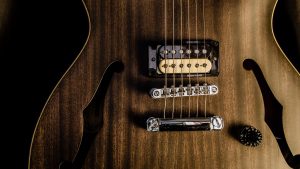You don’t have to be a big jazz fan to boost your guitar skills with some jazz techniques. In this guest post, Matt Warnock from mattwarnockguitar.com teaches you 10 must-know jazz guitar scales.
Even if you’ve never played jazz guitar before, you’ve probably come across numerous articles and lessons exploring jazz guitar scales.
There seems like an endless mountain of scales to learn when exploring jazz on the fretboard, and they all come with strange names and sound even stranger.
If you’ve ever wanted to explore jazz guitar soloing, but were overwhelmed by the number of scales to learn, or even where to start, then this lesson is for you!
In this lesson, you’ll learn the 10 most important guitar scales for jazz guitar, how they’re built, how to play them on guitar, and how to use them in your guitar solos.
What Scales Do Jazz Guitar Players Use?
There are several jazz guitar scales modes that you need to master if you’re learning how to play jazz guitar songs.
In total, there are 7 modes that are derived from the major scale, with each adding a totally different tone or feel to your solo. These include:
- Dorian – one of the most common of all jazz scale, with a pattern of “whole, half, whole, whole, whole, half, whole”
- Ionian – the familiar major scale
- Phrygian – the jazz melodic minor scale guitar mode with Spanish flair
- Lydian – a beautiful scale that you can play over a major chord
- Locrian – a great jazz guitar scale for playing a solo over half-diminished chords
- Aeolian – a natural minor scale with a unique sound
- Mixolydian – a dominant chord scale with a bluesy sound
Outside of these common jazz scales guitar players will learn, there are other less common ones you can choose to learn, too – such as augmented or tritone.
In any event, learning how to play any of these jazz guitar scales is a great way to add color, character, and a unique flair to your playing. This technique can prevent songs from becoming boring, stale, or predictable.
Check out this video with more fun details on how to play jazz guitar scales:
Patterns, Scales, & Modes for Jazz Guitar
There are more essential jazz guitar scales to learn if you go further with your jazz guitar studies, but these 10 scales are more than enough to get a jazz sound in your solos.
To help you learn these jazz guitar scales from a theory perspective, each scale will have a three-point breakdown of its construction and application.
This breakdown works like this:
- Interval Pattern: How to build the scale.
- Used Over: What chord to use this scale over.
- Sounds Like: What the scale sounds like over that chord.
Once you’ve learned the theory behind any of these 10 jazz guitar scales, you’ll be ready to take them to the fretboard and add them into your jazz guitar solos.
Now it’s time to begin learning these 10 jazz scales, working them from a technical perspective, and using them to jazz up your guitar solos in any genre of music.
10 Jazz Guitar Scales to Learn
Ready to start mastering jazz guitar? Here are 10 jazz guitar scales to start with.
1. Dominant Bebop Scale
The first jazz scale that you’ll explore is one of the most jazz sounding scales out there, the dominant bebop scale.
This scale is built by adding a major 7th passing tone to a Mixolydian scale, creating an 8-note scale that’s used to solo over dominant 7th chords.
Here’s the interval pattern for the dominant bebop scale.
- Interval Pattern: R 2 3 4 5 6 b7 7
- Used Over: 7th Chords
- Sounds Like: 7th Chord
With that knowledge under your belt, it’s time to take this scale to the guitar. The first step is to listen to the scale in a one-octave shape.
You can also play this one-octave scale in order to begin taking the dominant bebop scale onto the guitar fretboard.

To help you take this scale further on the fretboard, here are several two-octave shapes that you can practice in the woodshed.
Be sure to work these dominant bebop scale shapes with a metronome as well as solo with them over backing tracks in your studies.
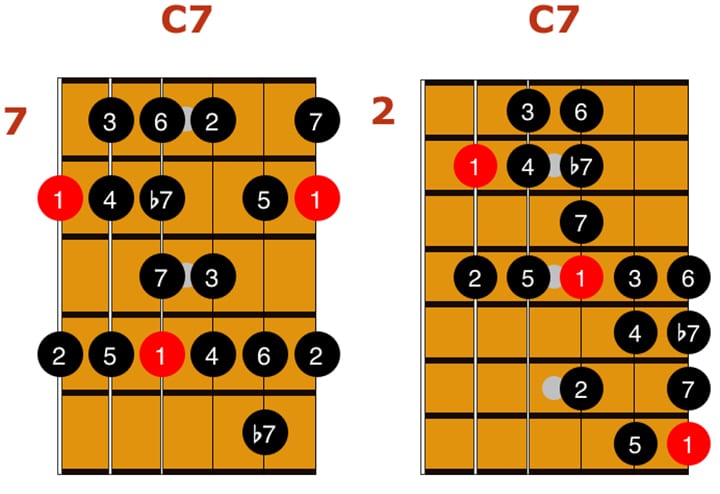
One of the best ways to work scales is to learn jazz guitar licks that use those scales in their construction.
Here’s a sample dominant bebop lick that you can learn, work with a metronome, and add to your soloing practice routine over backing tracks.

Make sure to practice using this lick in your soloing, rather than only working it with a metronome. Jazz soloing is a learned skill, so practice just like you practice learning scales in your guitar practice routine.
2. Minor Bebop Scale
You can also explore a minor key bebop scale, which is used to solo over M7 chords in a jazz context.
Here’s the interval pattern for this eight-note scale, which is built in a similar way to the dominant bebop scale.
Here, you’re adding a passing note to the Dorian scale, which ends up being a Dorian with an added major 7th interval.
- Interval Pattern: R 2 b3 4 5 6 b7 7
- Used Over: m7 Chords
- Sounds Like: m7 Chord
Now that you know how to build the minor bebop scale, here’s how it sounds and looks on paper.
Give this scale a try to see how it sits on the fretboard and how it sounds when you play it on your instrument.

After exploring this scale in a one-octave shape, you’re ready to take it around the fretboard using these two, two-octave scale shapes.
Make sure to practice these shapes with your metronome and use them to solo over chord changes in your improvisational practice routine.
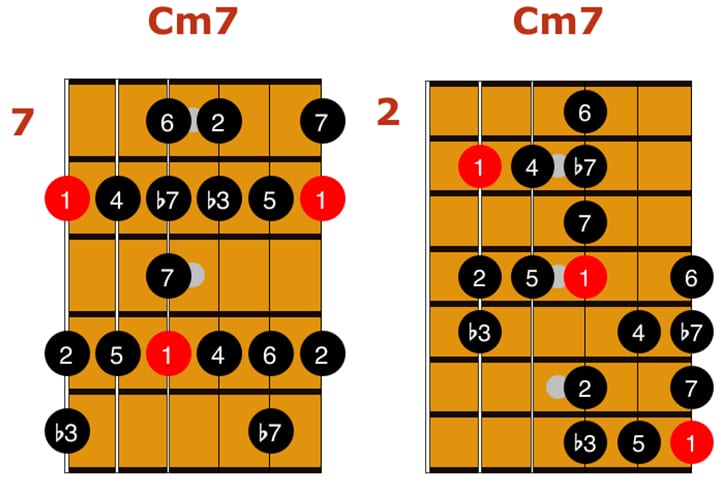
This sample phrase uses a Pat Metheny inspired run over the m7 chord at the start of the progression, built from the minor bebop scale.

Once you have this lick under your fingers, practicing personalizing this line as you begin to change the rhythm, add notes, take notes away, etc.
3. ii V Bebop Scale
You can play the minor and dominant bebop scales separately, and you can also combine them to form a nine-note scale that’s used over both m7 and 7th chords.
When doing so, combine the iim7 and V7 chords in a key, Dm7-G7 in C major, for example, and use the extra notes in those bebop scales together.
After combining the two scales, you produce the following interval pattern:
- Interval Pattern: R 2 b3 3 4 5 6 b7 7
- Used Over: m7 and 7th Chords
- Sounds Like: m7 and 7th Chord
Here is the nine-note ii V bebop scale on paper, so you can get your fingers and ears around this chromatic sounding jazz guitar scale.

To take things further, here are two different ii V bebop scale fingerings that you can work with a metronome and solo in your improv practice routine.
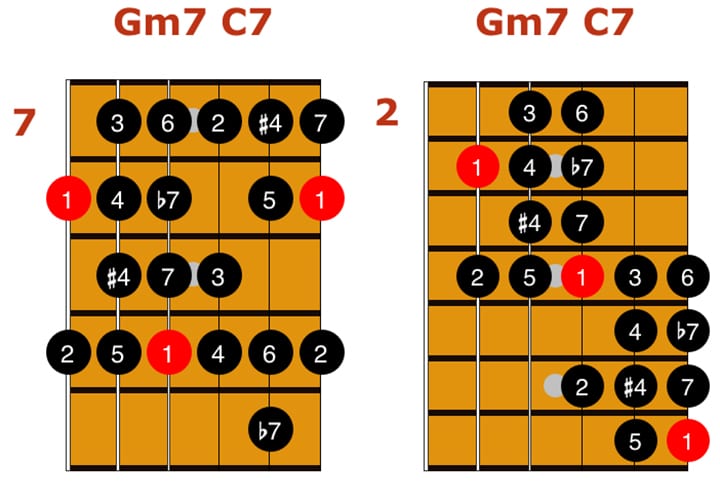
To finish off your intro to the ii V bebop scale, here’s a ii V I lick that uses this scale to solo over the first two chords in the progression.

When you’re ready, make sure to take this lick to other keys, which will allow you to apply this phrase to your solos in any key that you’re playing in on a tune.
4. Melodic Minor Scale
The melodic minor scale is used in many styles of music, though in jazz it differs from its classical music cousin.
In classical music, you play one version of the scale ascending and one version descending.
But in jazz, you only play the ascending version of the scale, which you can see in the interval pattern below.
You can then use this version of melodic minor, often called jazz minor, to color m7 chords in your solos, giving them a mMaj7 sound along the way.
- Interval Pattern: R 2 b3 4 5 6 7
- Used Over: m7 Chords
- Sounds Like: mMaj7 Chord
Here’s how the melodic minor scale looks and sounds on the staff. Give this scale a try to see how it sounds compared to the other minor modes you know.

To help you take this scale to the guitar, here are two, two-octave melodic minor scale shapes that you can practice in 12 keys on the guitar.
*Make sure to put on a backing track and work on soloing with this scale in the improvisational section of your routine.
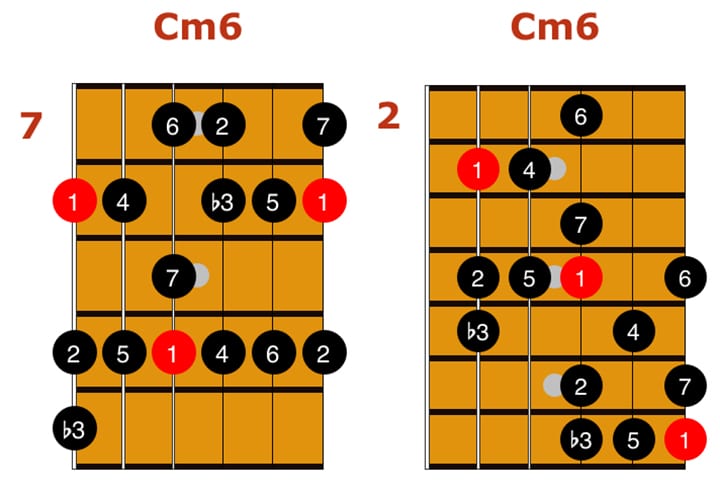
Lastly, here’s a common application of the melodic minor scale in a jazz context, used to solo over a iim7 chord in a ii V I chord progression.
The phrase in bar one of the line is a common melodic minor lick, one that you can extract from this longer line and use in other musical contexts.

Once you have this lick under your fingers, make sure to practice soloing with it over various m7 chords, keys, and tempos.
5. Lydian Dominant Scale
The next scale is one of the most popular scales in jazz, the 4th mode of melodic minor, otherwise known as the Lydian dominant scale.
This scale is used to color your 7th chord lines by bringing out the 7#11 sound over those chords.
Here’s the interval structure of Lydian dominant so you can get your fingers and ears around the theory behind this popular jazz scale.
- Interval Pattern: R 2 3 #4 5 6 b7
- Used Over: 7th Chords
- Sounds Like: 7#11 Chord
Here is that interval breakdown on paper,so you can see and hear this scale as you introduce your fingers and ears to the Lydian dominant scale.
 Now that you know how to build the Lydian dominant scale, you can take it to the fretboard with these two-octave scale shapes.
Now that you know how to build the Lydian dominant scale, you can take it to the fretboard with these two-octave scale shapes.
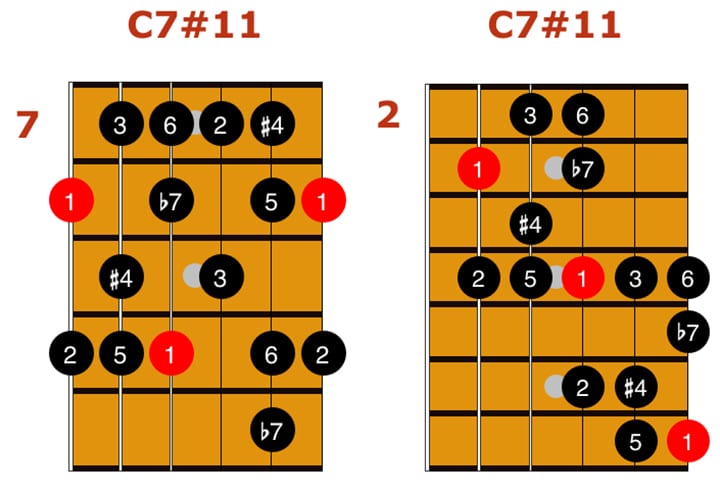
Here is a sample lick that uses a classic Lydian dominant sound over the V7 chord in a ii V I in F major.
If you dig the phrase over C7, feel free to extract that and use it over other chords and in other musical situations in your solos.

Make sure you work this lick with a metronome, in various keys, as well as add it into your solos.
Learning how to improvise, in jazz or any genre, is easier when you practice improvising in the woodshed.
6. Altered Scale
You’re now going to explore one of the most famous jazz guitar scales, the altered scale, so named because it outlines the 7alt chord in your solos.
This scale, the 7th mode of melodic minor, produces the chord 7(b9,#9,b5,#5), which is shortened to 7alt in lead sheets and chord charts.
Here’s how the altered scale looks on paper.
- Interval Pattern: R b2 b3 3 b5 b6 b7
- Used Over: 7th and 7alt Chords
- Sounds Like: 7alt Chord
Now that you can build an altered scale, get your fingers and ears around this new scale with the following one-octave fingering.

To take this scale around the fretboard, here are two altered scale shapes that you can work with a metronome and add to your solos over backing tracks.
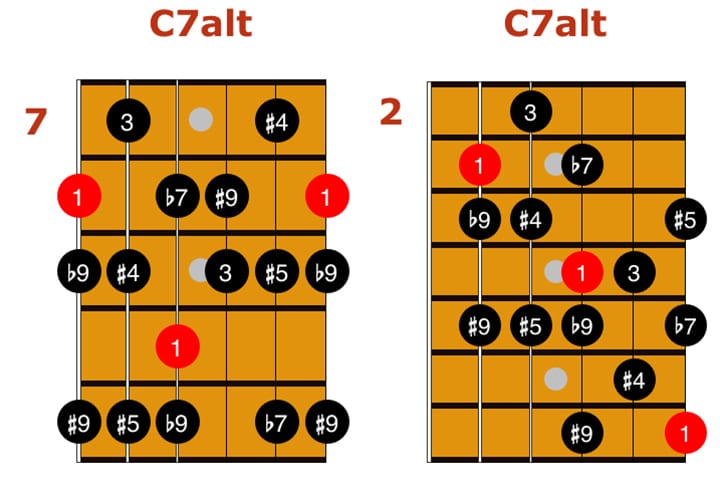
The sample lick for this scale uses a classic altered scale pattern over the second bar, C7alt, of the ii V I lick in F minor.
If you enjoy that part of the phrase, you can pull it out of this lick and apply it to other contexts in your soloing, just the second bar.

When working on this, or any lick, make sure to personalize it by changing the rhythms, adding notes, and taking notes away.
7. Phrygian Dominant Scale
You’ll now look at the 5th mode of the harmonic minor scale, otherwise known as the Phrygian dominant scale.
Harmonic minor modes are rarely used in jazz soloing, with the exception of the 5th mode, which is used all the time to bring a 7b9,b13 sound over 7th chords.
Here’s how the interval pattern lays out for the Phrygian dominant scale.
- Interval Pattern: R b2 3 4 5 b6 b7
- Used Over: 7th and 7alt Chords
- Sounds Like: 7b9,b13 Chord
To introduce your ears and fingers to this jazz guitar scale, here’s how the Phrygian dominant scale sounds and looks on paper.

Now that you know how to build this scale, here are two Phrygian dominant scale fingerings that you can use in your technical and soloing workout.
Once you have both of these shapes under your fingers, work on moving between the two shapes in your solos to cover more of the fretboard in your improvisations.
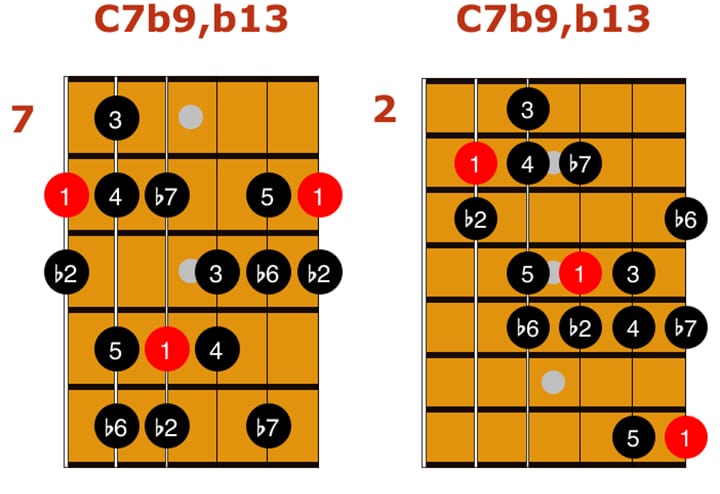
To finish your introduction to this scale, here’s a lick with the Phrygian dominant scale outlining the C7 chord in the second bar of the phrase.

Make sure to practice this lick in different keys and at various tempos, as well as adding it into your solos to work it into your improvisations.
8. Mixolydian b9 Scale
Moving on, you’re now going to learn the 5th mode of the harmonic major scale (1 2 3 4 5 b6 7), which is referred to as the Mixolydian b9 scale.
This scale gets its name because if you take a Mixolydian scale and lower the 2nd (9th), you produce the 5th mode of harmonic major.
You can use this scale to color 7th chords, as you bring a 7b9 sound to your dominant chord soloing in a jazz (or other genre) solo.
Here’s how the Mixolydian b9 scale looks on paper.
- Interval Pattern: R b2 3 4 5 6 b7
- Used Over: 7th Chords
- Sounds Like: 7b9 Chord
Now that you know how to build this scale, here’s the Mixolydian b9 on paper so you can see and hear the interval structure.
Don’t forget to play through this scale in the one-octave fingering below, to give your ears and fingers a chance to explore this sound before moving on.

To help you take the Mixolydian b9 scale around the fretboard, here are two, two-octave shapes that you can learn and apply to your guitar solos.
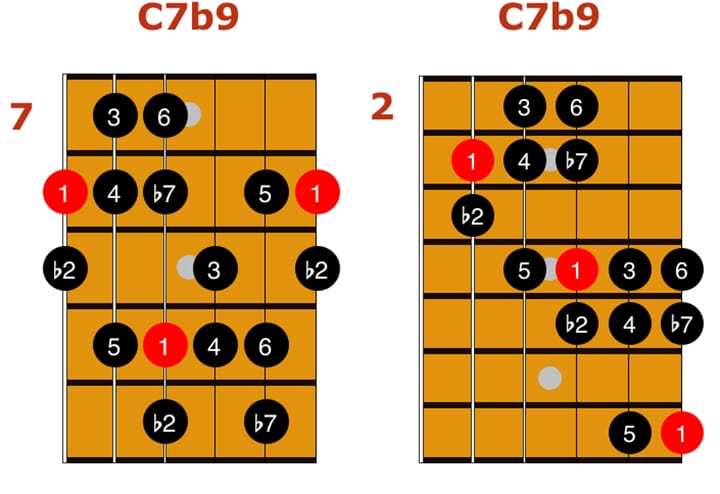
Taking this scale into the improvisational realm, here is a ii V I lick in F major where the Mixolydian b9 scale is used to color the C7 in bar 2 of the lick.

Once you have this lick under your fingers, work it in 12 keys, at various tempos, and apply it to your soloing practice to get the most out of this lick study.
9. Tritone Scale
You’re now going to step outside of the usual melodic minor, bebop, and harmonic minor modes, and explore a symmetrical scale.
The tritone scale is built by combining two major triads a tritone apart, like C and F#, on the fretboard.
When you line up those six notes in alphabetical order, you get the following interval pattern and construction.
- Interval Pattern: R b2 3 #4 5 b7
- Used Over: 7th and 7alt Chords
- Sounds Like: 7b9,#11 Chord
Here’s how the tritone scale looks on the fretboard, and sounds, so you can introduce your fingers and ears to this cool, but rare, jazz scale.

Now that you know how to build the tritone scale, and what it sounds like, you’re ready to take this scale to the fretboard.
Here are two, two-octave tritone scale shapes that you can learn, practice in all 12 keys, and apply to your soloing over 7th chords when working with backing tracks.
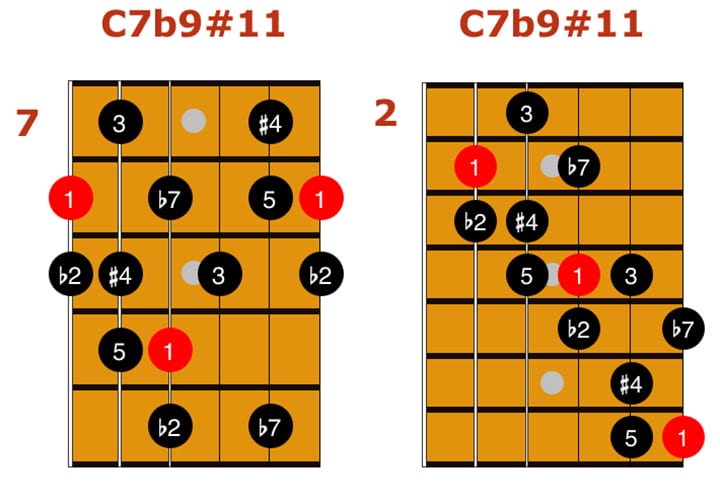
To finish your intro to the tritone scale, here is a lick that uses the C tritone scale over the C7 chord V7, in a ii V I progression.
Notice the tension this scale creates in the second bar of the lick that’s then resolved to the Fmaj7 chord in the final measure.
Using outside sounding scales, like the tritone scale, can be effective in your solos, but if you don’t resolve them properly they might sound like a mistake.
To paraphrase Stevie Ray Vaughan:
“It’s easy to go outside, it’s really hard to get back inside.”
So make sure to always have a plan to get back to a more stable sound when applying the tritone scale to your solos, to avoid sounding out of place.

Once you have this lick under your fingers with a metronome, practice applying it to your solos over a backing track.
Start by playing the lick as is, then begin to adapt the lick by changing the rhythm, adding notes, taking notes away, etc.
This will allow you to keep the vibe of the lick in your playing, but also personalize the lick along the way.
10. Augmented Scale
The final scale is an outside sounding scale that you can use to add flavor to your maj7 chords when soloing in the jazz style.
The augmented scale isn’t for everyone, but with the right touch, it can be used to increase the intensity over Imaj7 and IVmaj7 chords in your jazz guitar solos.
To build an augmented scale, you can play two augmented triads a minor 3rd apart, such as C and Eb.
Then, when you lay out those six notes in order, you get the following interval pattern.
- Interval Pattern: R b3 3 5 #5 7
- Used Over: Maj7 Chords
- Sounds Like: Maj7#5 Chord
Here is how the augmented scale looks on paper and how it sounds in a one-octave scale shape.
After listening to the example, play this scale on the guitar to begin to see how it sits on the fretboard.

To help you take the augmented scale around the fretboard, here are two, two-octave augmented scale shapes that you can run through in your practice routine.
Don’t forget to practice these scales with a metronome, as well as over backing tracks, as you work these shapes from a technical and musical standpoint.
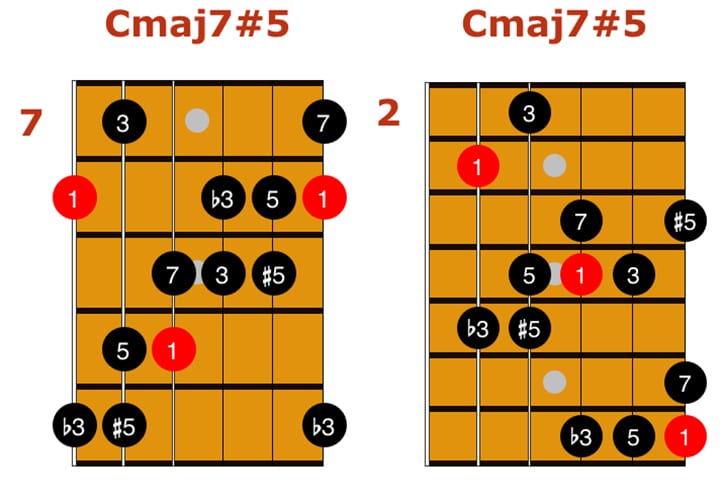
Lastly, here is a sample augmented scale lick that you can learn and use in your solos when improvising with this cool sounding scale.
Learn the lick in one key first, then, when you’re ready, bring it to all 12 keys as you work this line across the entire guitar fretboard.

Resources for Learning Jazz Guitar Scales
There are all kinds of resources you can turn to as you’re learning jazz guitar scale patterns.
Here are a few great jazz guitar scales YouTube videos:
3 Jazz Scales You Need to Practice
The Most Important Scale Exercise in Jazz
Pentatonic Jazz Guitar Scales
…and here are some jazz scales guitar tabs you can try out.
Of course, working with a talented guitar instructor and taking guitar lessons is another excellent way to learn the best scales for solos!
This list of the 10 jazz scales every guitarist should know and work on in their practice routines is a great place to start, too.
What are the Best Scales for Jazz?
If you’re looking to add a bit of jazz flavor to your solos, or just step outside the box in your playing, then these 10 guitar solo scales are just what you need to expand your playing.
If you have any questions about these scales, please post it in the comments section below; I’ll be glad to help you out.
And, if you want to take your jazz guitar playing further, check out my free Beginner’s Guide to Jazz Guitar eBook.
Looking for more jazz guitar lessons to become a jazz scale guitar pro? Check out these articles and tutorials!
 Guest Post Author: Matt Warnock
Guest Post Author: Matt WarnockMatt Warnock is the owner of mattwarnockguitar.com, where over 1 million guitarists have learned to play jazz guitar. As well, he helps music teachers build, develop, and grow their online teaching businesses through his website teachmusiconline.com.
Maile Proctor




